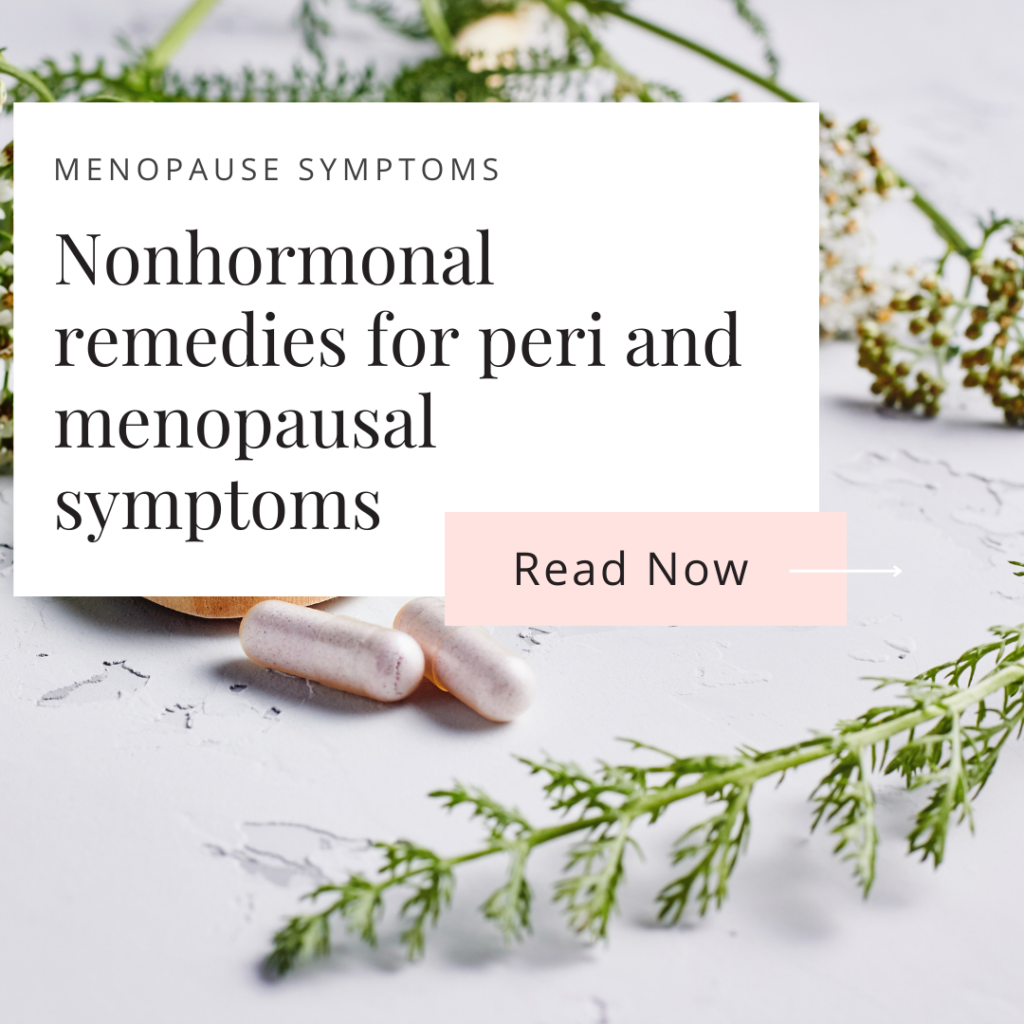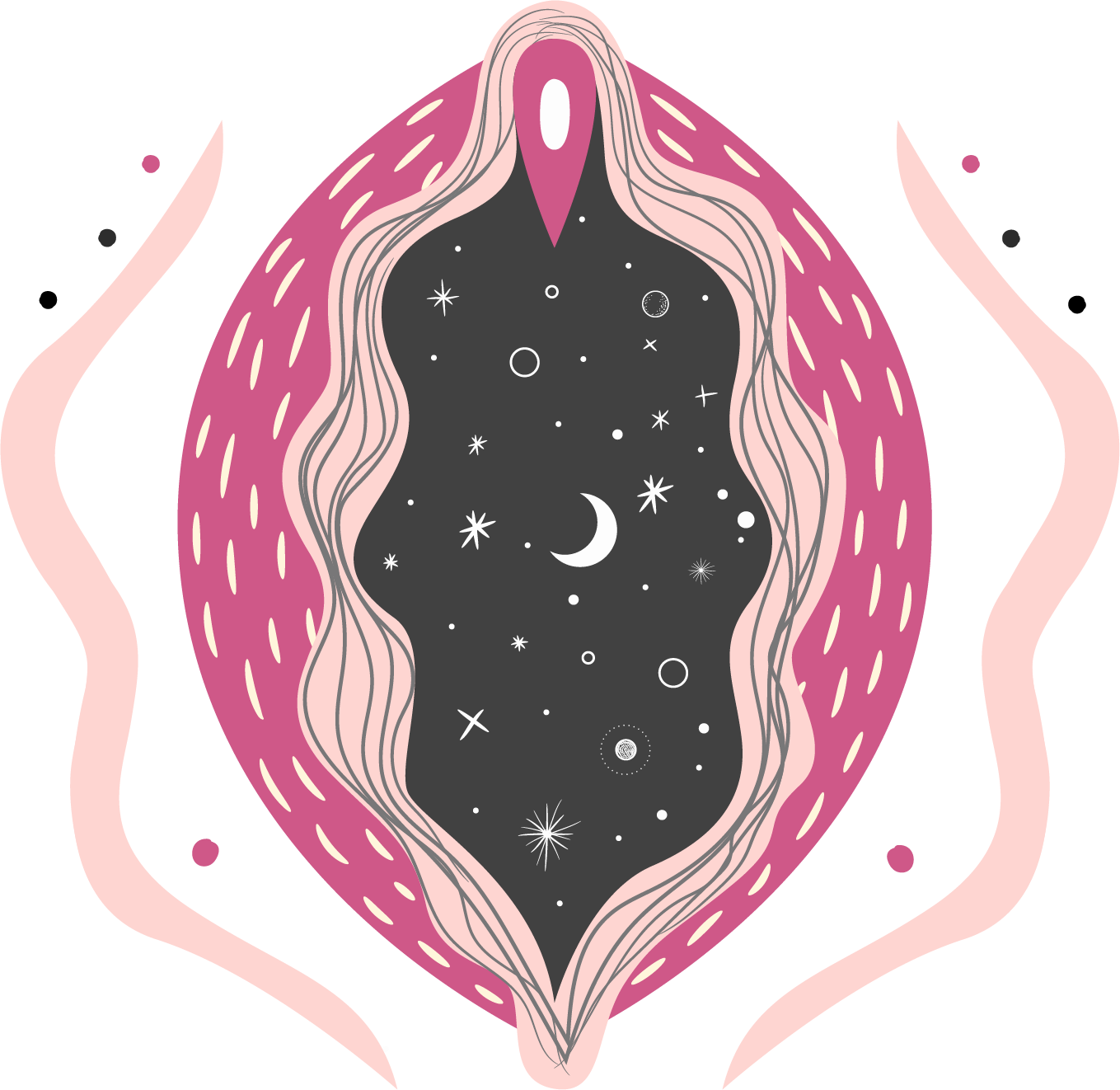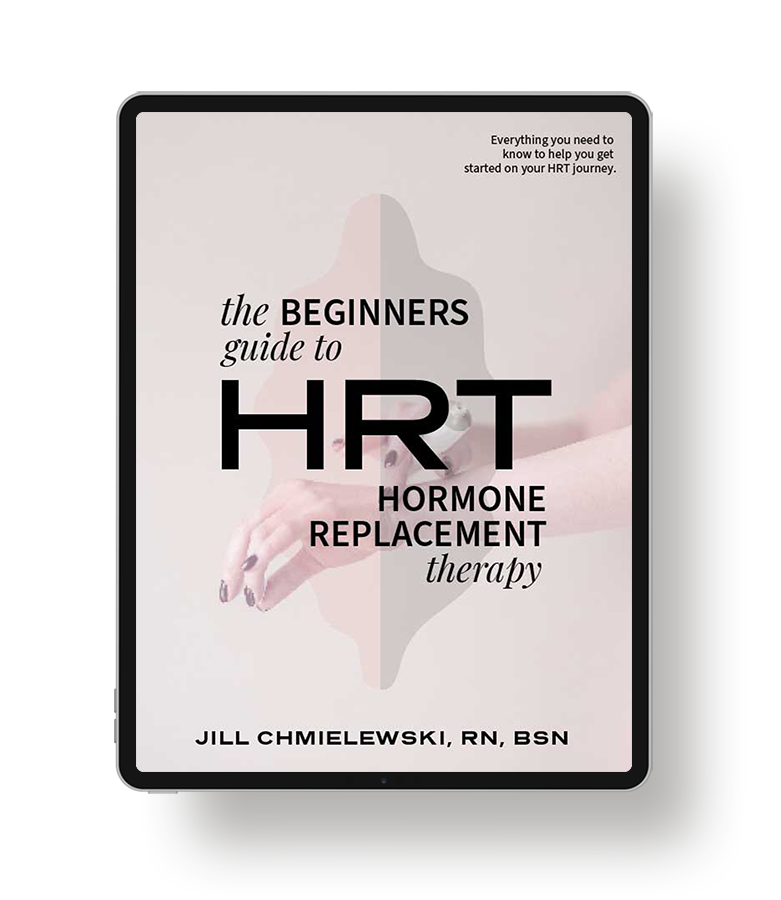
I’m often asked whether nonhormonal remedies are an effective alternative to hormone replacement therapy (HRT) for women transitioning from perimenopause to menopause (and beyond).
If you are a member of my Pausing Together Community, and you’ve taken the time to read through the educational content in the Content Library, and you’ve listened to the Q&A with Dr. Rosensweet, our community’s menopausal guest expert, then you know that hormones are the most potent biochemical molecules in the human body.
Hormones communicate messages to our cells by signaling hormone receptors throughout the body. While some plant molecules and other herbs or treatments can signal hormone receptors, hormone receptors (as their name implies) receive signals from hormones. Hence the name “hormone receptor.”
Hormone receptors weren’t discovered until the 1990s, so it’s safe to say that we still have much to learn about hormone receptors’ function. That said, we do know a few things about our hormone receptors:
Hormone receptors are promiscuous.
You’d think that the human body would be designed so that hormones could only nestle into hormone-specific receptors. (i.e., estrogen nestles into an estrogen receptor, progesterone into a progesterone receptor, and so forth). But that’s not the case. Hormones can nestle into many hormone receptors, and receptors are not discerning about which hormones they allow to nestle in. In that way, you might think about hormones and receptors as being “promiscuous.”
Hormone-mimicking chemicals (i.e., chemicals that resemble hormones or have hormone-like properties) can signal hormone receptors. Many of these manufactured chemicals are why we gals have hormone imbalances and other health issues.
Some molecules like phytoestrogens, estrogen-like substances made by some plants, can signal hormone receptors (i.e., soy signals the estrogen-receptor beta, etc.).
Certain nutrients work as hormone helpers at the receptor site. They enhance hormone signals, dictate how long a hormone signals, and help to clear hormone receptors after a hormone has signaled.
When searching for a nonhormonal remedy to replace our hormones or take on the job that our hormones provide, it’s important to consider what you hope to achieve with that remedy.
Hormones are powerful chemical messengers that provide benefits throughout the body. They protect the brain, bones, muscles, blood vessels, vagina, skin, heart, digestive tract, and more. Hormone therapy is prescribed not only to reduce or resolve pesky pausal symptoms but to protect the entire body and help prevent many of the chronic health issues that result from hormone deficiency.
So, the question you need to ask yourself is: What is my goal?
Is your goal simply to get a better night’s sleep, alleviate hot flashes, and address a dry vagina? Or is your goal to support your body systemically ~ brain, blood vessels, bones, and everything in between?
Herbs, nutrients, and other supplements can help alleviate or reduce symptoms for many women, but the more significant concern is the long-term ramifications of hormone insufficiency. Women are living much longer than ever before. Just over 100 years ago, the average life expectancy for women in the U.S. was 50 years. Since the average age of menopause is 51, the average woman never had to worry about the ramifications of hormone insufficiency for a third to half of her life.
Living 30 to 40 years beyond menopause is a new reality for most women. Food, lifestyle factors, and supplements may help, but there is nothing that can fill the BIG shoes that your hormones have left behind. It’s like telling a type 1 diabetic you will use an alternative to insulin and hope for the same results that insulin provides. There is no alternative that will work as effectively as insulin.
The importance of assessing the effectiveness of nonhormonal remedies
If you decide to pursue a nonhormonal treatment, it’s important to assess the effectiveness of the treatment(s) you’ve chosen, just as you would if you chose to pursue hormone therapy. If your primary goal of the treatment is to alleviate symptoms, you’ll know quickly whether that treatment is effective. Symptoms should decline or disappear.
But if your primary goal of the treatment is to alleviate pesky symptoms AND to protect the brain, bones, blood vessels, and the rest of the body, then you simply assess your symptoms. Have your symptoms improved or resolved?
Once symptoms have resolved, you may consider taking that extra step and performing a 24-hour urine hormone test to see if your hormone levels are optimal and ensure that the remedy brought your hormone levels to the levels needed to protect the body. (The 24-hour urine hormone test from Rhein Labs or Meridian Valley is different from drying during testing or performing a 4- or 5-point test.)
If you don’t want to do hormone testing or don’t have access to testing, I’d recommend tracking bone changes, blood vessel changes, and vaginal changes over time. That will give you important feedback on whether your nonhormonal treatment(s) is doing its intended job.
We can’t feel bone or blood vessel changes, so monitoring your bones and blood vessels’ health is important to ensure that your body is not at risk. A heart attack is often the first sign that the blood vessels aren’t doing so great for most women. And for many women, a fall that results in a broken bone is the first sign that they’ve got bone loss. As far as vaginal changes go, most women paying attention to their bodies are aware when something feels different “down there.” But if not, an increased frequency of vaginal infections, urinary tract infections, or pain/discomfort with sex is a red flag that things are changing down there.
There’s no sense in taking a nonhormonal remedy if it won’t produce the results you want. If you decide to pursue a nonhormonal remedy, be sure to check in with yourself regularly to assess whether a treatment is working or needs some tweaking.
Let’s talk about specific nonhormonal remedies, shall we?
If you are interested in pursuing nonhormonal treatment options, keep in mind that it will take time to see results (versus using hormone replacement therapy). A study done by Li in 2015 [1] compared the use of soy isoflavones to estrogen therapy for the treatment of hot flashes and found that it took approximately three weeks for estrogen therapy to reach its maximum effect, while it took the soy isoflavones 48 weeks to reach its maximum effect. That’s quite a difference! Patience is key, and it’s important to be realistic with your expectations.
The other thing to consider when it comes to nonhormonal remedies is that studies comparing hormone therapies to nonhormonal therapies are lacking. If you know anything about the pharmaceutical industry, you know that there aren’t a lot of big bucks involved in selling natural therapies that have been around for a while. So, if you are looking for definitive “proof” of a particular treatment’s effectiveness in the form of peer-reviewed clinical trials or research studies, you’re probably not going to find what you are looking for.
That said, both hormone and nonhormone therapy have been around for years. Bio-identical hormones have been used for thousands of years, dating back to ancient China, where aging female nobility routinely ingested dried young women’s crystallized urine to counteract the symptoms associated with menopause and improve their quality of life.[2] Ancient Greek and Roman physicians used plant and animal products to slow or reverse aging, so these treatments have been around for a while.
Isoflavones (soy and red clover)
Isoflavones are a type of phytoestrogen in soy plants. Isoflavones are also antioxidants, which may reduce damage caused by free radicals.
Overall, the research on isoflavones as a treatment for pausal women has been inconsistent, likely because there are many different types of isoflavones, different doses, and because a woman must be able to break down the soy isoflavones daidzein and genistein into equol.
Equol is what signals estrogen receptor-beta.[3], [4] Equol production occurs in only 25-50% of humans (but 100% of animals),[5] which is why using isoflavones as the sole “treatment” for hormonal insufficiency may not be the best option for a large majority of women. Not everyone can break soy down into equol; hence, an S-equol supplement might be considered.
The research on soy isoflavones has shown that they may help to improve:
- Hot flashes [6]
- Vaginal dryness [7]
- Cardiovascular markers [8] and blood pressure [9]
- Bone health [10], [11], [12]
Below, I will share the research on specific nonhormonal therapies. Remember what I said earlier ~ there aren’t many studies on these remedies, so it’s up to you to decide which remedies most resonate with you. If you choose to use a remedy or combination of remedies, I’d recommend tracking your symptoms to see if they improve and doing follow-up testing and tracking if your goal is systemic protection.
Red clover
Red clover is an isoflavone that may improve hot flashes in postmenopausal women but has not been shown to improve hot flashes in perimenopausal women.[13]
Flaxseeds
Flaxseeds are in a class of foods known as phytoestrogens, meaning they have estrogen properties that can act like estrogen in the body. Phytoestrogens have a weaker estrogenic effect in the body compared to the estrogen that our bodies make. However, they can still be helpful when a woman suffers from low estrogen or wildly fluctuating estrogen.
Chaste tree berry
The Chaste tree berry (also known as Vitex) boosts dopamine and lowers prolactin, which can help to promote ovulation.[14] Typical dosing is 20-40 mg/day, cycled each month (21-25 days on, 5-7 days off). Most experts recommend avoiding Chaste tree if you suffer from PCOS, as it can increase luteinizing hormone (LH), which is often already elevated in many PCOS patients. Please note: Vitex will typically have minimal effect in menopausal women who are no longer ovulating.
Bee pollen
Bee pollen extract tends to help more with hot flashes that are present with sleep disturbances.[15]
Sage (Salva officinalis)
Sage may reduce hot flashes, sleep disturbances, and night sweats [16], [17]
St. John’s Wort
Hypericum perforatum (St. John’s Wort) 270-330 mg three times daily has improved both hot flashes and depression scores in menopausal women.[18] **Warning: Women on antidepressants should always consult with their physician before taking St. John’s Wort.
Black cohosh
The exact mechanism of action by which black cohosh works is not fully understood. Older studies suggest that black cohosh may have an estrogenic effect on the body, but newer research suggests that it may act on serotonin receptors instead, which can be helpful for hot flashes and mood improvement. Black cohosh (40-80 mg per day) combined with St. John’s Wort (300 mg three times daily) has improved some low estrogen symptoms.[19], [20] Warning: Women on antidepressants should always consult their physician before taking St. John’s Wort.
Valerian
Valerian has been used medicinally since early Greek and Roman times to treat sleeplessness, nervousness, trembling, headaches, and heart palpitations. Several studies have shown that Valerian may improve sleep quality in perimenopausal women suffering from insomnia.[21], [22] And unlike sleep aids that can cause grogginess in the morning, Valerian does not appear to affect alertness or concentration the following day. Valerian can take up to one month to see a noticeable benefit, but it may be worth considering if you suffer from sleeplessness due to low estrogen. Valerian (530 mg capsules twice daily) has also been shown to reduce the severity and frequency of hot flashes.[23]
Rhubarb
Rhubarb may help ease menopausal symptoms.[24]Estrovera by Metagenics contains rhubarb extract, which may improve menopausal night sweats and provide hot flash relief.
Adaptogenic herbs
Adaptogens such as Rhodiola, Ashwagandha, Eleuthero, or Panax Ginseng, can help to balance the stress response. It’s best to know your cortisol levels before using adaptogenic herbs, as different adaptogenic herbs are used for different reasons.
Maca root
Maca root is a cruciferous vegetable that may increase estrogen and has a modulatory effect across all your hormones. Maca works as an adaptogen for the adrenal glands and helps balance estrogen and progesterone levels by promoting optimal function of the hypothalamus and pituitary, thereby improving the function of all the endocrine glands, including the ovaries.
Bladderwrack
Bladderwrack is a brown seaweed that has been shown in some cases to help increase progesterone levels while lowering estrogen levels. Dosing is typically 700-1400 mg/day. Caution: Bladderwrack is a seaweed containing iodine, so it should be used with caution in women with autoimmune thyroid conditions.
Acupuncture
There are no or very few studies comparing acupuncture against HRT. Acupuncture is notoriously difficult to study, and the available studies do not publish point protocols, frequency of treatment, or other specifics needed to perform an effective comparison. That said, here are a few things that we know from the research:
A study published in 2021 by Zhao [25] showed that acupuncture improved sleep compared with sleep hypnotics (as measured by the Pittsburgh Sleep Quality Index and Kupperman Index). Acupuncture combined with hypnotics was more effective than hypnotics alone. This study also showed an improvement in mood.
Another study published in 2020 by Li [26] showed that acupuncture improved sleep scores in perimenopausal women.
A meta-analysis by Xiao[27] published in 2020 found acupuncture more effective than antidepressants for mood issues and had significantly fewer side effects than antidepressants.
A study published by Avis in 2017[28] found the greatest predictor for response to acupuncture for hot flashes was the number of treatments over the first eight weeks. Consistency is key!
Medications
Paroxetine (Brisdelle®, Paxil®) – The only antidepressant that is FDA-approved specifically for treating hot flashes. Other anti-depressants that are often prescribed but not specifically approved for hot flashes include Venlafaxine (Effexor®), escitalopram (Lexapro®), citalopram (Celexa®), fluoxetine (Prozac®), and sertraline (Zoloft®).
Gabapentin (Neurontin®) is a drug primarily used to treat seizures but has been found to relieve/reduce hot flashes in some women. It comes with many side effects, including tremors and loss of appetite.
Oxybutynin is a drug usually used to treat overactive bladder and urinary incontinence. It has also been shown to reduce hot flashes (vasomotor symptoms) in some women. Most women using it report severe dry mouth.
Clonidine is approved in the UK for hot flashes. It comes with a long list of side effects.
Fezolinetant (Veozah®) was recently approved by the FDA in May 2023 for treating hot flashes. The active ingredient in Veozah works by blocking NKB in the brain’s temperature control part. A 30-day supply will cost around $500.
Final thoughts
The bottom line is that nonhormonal remedies aren’t hormones, which means they won’t provide the same benefits as your hormones. That said, many women have experienced great support and benefits from nonhormonal remedies over the years.
YOU live in your body, meaning you can decide how to support your body during perimenopause, menopause, and beyond. Other options exist if you feel that HRT is not the right remedy. And if you decide later down the line that nonhormonal remedies aren’t providing the results you need, you can always pursue HRT.
Important medical disclaimer
This content is for informational purposes only and is not a substitute for professional medical advice. None of the recommendations, suggestions, or written information provided is intended to replace a one-on-one relationship with a qualified health care professional. The information presented is not intended to diagnose, treat, cure, or prevent any disease but rather as a sharing of knowledge and information from the research and experience of Jill Chmielewski, RN, BSN. You are encouraged to make your own health care decisions based on your research and partnership with a qualified healthcare professional of your choosing.
References
[1] Li L, Lv Y, Xu L, Zheng Q. Quantitative efficacy of soy isoflavones on menopausal hot flashes. Br J Clin Pharmacol. 2015 Apr;79(4):593-604. doi: 10.1111/bcp.12533. PMID: 25316502; PMCID: PMC4386944.
[2] https://hormonetherapyaugusta.com/brief-ancient-history.html
[3] Daily JW, Ko BS, Ryuk J, Liu M, Zhang W, Park S. Equol Decreases Hot Flashes in Postmenopausal Women: A Systematic Review and Meta-Analysis of Randomized Clinical Trials. J Med Food. 2019 Feb;22(2):127-139. doi: 10.1089/jmf.2018.4265. Epub 2018 Dec 28. PMID: 30592686.
[4] Słupski W, Jawień P, Nowak B. Botanicals in Postmenopausal Osteoporosis. Nutrients. 2021 May 11;13(5):1609. doi: 10.3390/nu13051609. PMID: 34064936; PMCID: PMC8151026.
[5] Mayo B, Vázquez L, Flórez AB. Equol: A Bacterial Metabolite from The Daidzein Isoflavone and Its Presumed Beneficial Health Effects. Nutrients. 2019 Sep 16;11(9):2231. doi: 10.3390/nu11092231. PMID: 31527435; PMCID: PMC6770660.
[6] Daily JW, Ko BS, Ryuk J, Liu M, Zhang W, Park S. Equol Decreases Hot Flashes in Postmenopausal Women: A Systematic Review and Meta-Analysis of Randomized Clinical Trials. J Med Food. 2019 Feb;22(2):127-139. doi: 10.1089/jmf.2018.4265.
[7] Franco OH, Chowdhury R, Troup J, Voortman T, Kunutsor S, Kavousi M, Oliver-Williams C, Muka T. Use of Plant-Based Therapies and Menopausal Symptoms: A Systematic Review and Meta-analysis. JAMA. 2016 Jun 21;315(23):2554-63. doi: 10.1001/jama.2016.8012. PMID: 27327802.
[8] Moradi M, Daneshzad E, Azadbakht L. The effects of isolated soy protein, isolated soy isoflavones and soy protein containing isoflavones on serum lipids in postmenopausal women: A systematic review and meta-analysis. Crit Rev Food Sci Nutr. 2020;60(20):3414-3428. doi: 10.1080/10408398.2019.1689097. Epub 2019 Dec 20. PMID: 31858808.
[9] Kou T, Wang Q, Cai J, Song J, Du B, Zhao K, Ma Y, Geng B, Zhang Y, Han X, Jiang M, Guo H, Hu B, Li Z, Zhai Y, Zhang C. Effect of soybean protein on blood pressure in postmenopausal women: a meta-analysis of randomized controlled trials. Food Funct. 2017 Aug 16;8(8):2663-2671. doi: 10.1039/c6fo01845a. PMID: 28675204.
[10] Pabich M, Materska M. Biological Effect of Soy Isoflavones in the Prevention of Civilization Diseases. Nutrients. 2019 Jul 20;11(7):1660. doi: 10.3390/nu11071660. PMID: 31330799; PMCID: PMC6683102.
[11] Zhang X, Liu Y, Xu Q, Zhang Y, Liu L, Li H, Li F, Liu Z, Yang X, Yu X, Kong A. The effect of soy isoflavone combined with calcium on bone mineral density in perimenopausal Chinese women: a 6-month randomised double-blind placebo-controlled study. Int J Food Sci Nutr. 2020 Jun;71(4):473-481. doi: 10.1080/09637486.2019.1673703. Epub 2019 Oct 4. PMID: 31583921.
[12] Akhlaghi M, Ghasemi Nasab M, Riasatian M, Sadeghi F. Soy isoflavones prevent bone resorption and loss, a systematic review and meta-analysis of randomized controlled trials. Crit Rev Food Sci Nutr. 2020;60(14):2327-2341. doi: 10.1080/10408398.2019.1635078. Epub 2019 Jul 10. PMID: 31290343.
[13] Kanadys W, Barańska A, Błaszczuk A, Polz-Dacewicz M, Drop B, Kanecki K, Malm M. Evaluation of Clinical Meaningfulness of Red Clover (Trifolium pratense L.) Extract to Relieve Hot Flushes and Menopausal Symptoms in Peri- and Post-Menopausal Women: A Systematic Review and Meta-Analysis of Randomized Controlled Trials. Nutrients. 2021 Apr 11;13(4):1258. doi: 10.3390/nu13041258. PMID: 33920485; PMCID: PMC8069620.
[14] van Die, M Diana et al. “Vitex agnus-castus extracts for female reproductive disorders: a systematic review of clinical trials.” Planta Medica vol. 79,7 (2013): 562-75. doi:10.1055/s-0032-1327831
[15] De Franciscis, Pasquale et al. “Non-hormonal Treatments For Menopausal Symptoms and Sleep Disturbances: A Comparison Between Purified Pollen Extracts and Soy Isoflavones.” Current pharmaceutical design vol. 26,35 (2020): 4509-4514. doi:10.2174/1381612826666200721002022
[16] Zeidabadi, Afsaneh et al. “The effect of Salvia officinalis extract on symptoms of flushing, night sweat, sleep disorders, and score of forgetfulness in postmenopausal women.” Journal of family medicine and primary care vol. 9,2 1086-1092. 28 Feb. 2020, doi: 10.4103/jfmpc.jfmpc_913_19
[17] Dadfar, Fereshteh, and Kourosh Bamdad. “The effect of Saliva officinalis extract on the menopausal symptoms in postmenopausal women: An RCT.” International journal of reproductive biomedicine vol. 17,4 287–292. 28 May. 2019, doi:10.18502/ijrm.v17i4.4555
[18] Eatemadnia, Alieh et al. “The effect of Hypericum perforatum on postmenopausal symptoms and depression: A randomized controlled trial.” Complementary therapies in medicine vol. 45 (2019): 109-113. doi: 10.1016/j.ctim.2019.05.028
[19] Uebelhack, Ralf, et al. “Black Cohosh and St. John’s Wort for Climacteric Complaints.” Obstetrics & Gynecology, vol. 107, no. 2, Part 1, 2006, pp. 247–255., doi:10.1097/01.aog.0000196504.49378.83.
[20] Chung, Da-Jung, et al. “Black Cohosh and St. John’s Wort (GYNO-Plus®) for Climacteric Symptoms.” Yonsei Medical Journal, vol. 48, no. 2, 2007, p. 289., doi:10.3349/ymj.2007.48.2.289.
[21] Taavoni, S., et al. “Valerian/Lemon Balm Use for Sleep Disorders during Menopause.” Complementary Therapies in Clinical Practice, vol. 19, no. 4, 2013, pp. 193–196., doi:10.1016/j.ctcp.2013.07.002.
[22] Taavoni, Simin, et al. “Effect of Valerian on Sleep Quality in Postmenopausal Women.” Menopause, vol. 18, no. 9, 2011, pp. 951–955., doi:10.1097/gme.0b013e31820e9acf.
[23] Jenabi, Ensiyeh et al. “The effect of Valerian on the severity and frequency of hot flashes: A triple-blind randomized clinical trial.” Women & health vol. 58,3 (2018): 297-304. doi:10.1080/03630242.2017.1296058
[24] Dietz, Birgit M., et al. “Botanicals and Their Bioactive Phytochemicals for Women’s Health.” Pharmacological Reviews, vol. 68, no. 4, 2016, pp. 1026–1073., doi:10.1124/pr.115.010843.
[25] Zhao FY, Fu QQ, Kennedy GA, Conduit R, Wu WZ, Zhang WJ, Zheng Z. Comparative Utility of Acupuncture and Western Medication in the Management of Perimenopausal Insomnia: A Systematic Review and Meta-Analysis. Evid Based Complement Alternat Med. 2021 Apr 26;2021:5566742. doi: 10.1155/2021/5566742. PMID: 33986818; PMCID: PMC8093060.
[26] Li S, Wang Z, Wu H, Yue H, Yin P, Zhang W, Lao L, Mi Y, Xu S. Electroacupuncture versus Sham Acupuncture for Perimenopausal Insomnia: A Randomized Controlled Clinical Trial. Nat Sci Sleep. 2020 Dec 22;12:1201-1213. doi: 10.2147/NSS.S282315. PMID: 33376432; PMCID: PMC7764880.
[27] Xiao X, Zhang J, Jin Y, Wang Y, Zhang Q. Effectiveness and Safety of Acupuncture for Perimenopausal Depression: A Systematic Review and Meta-Analysis of Randomized Controlled Trials. Evid Based Complement Alternat Med. 2020 Jan 19;2020:5865697. doi: 10.1155/2020/5865697. PMID: 32051687; PMCID: PMC6995321.
[28] Avis NE, Coeytaux RR, Levine B, Isom S, Morgan T. Trajectories of response to acupuncture for menopausal vasomotor symptoms: the Acupuncture in Menopause study. Menopause. 2017 Feb;24(2):171-179. doi: 10.1097/GME.0000000000000735. PMID: 27676631; PMCID: PMC5266651.





